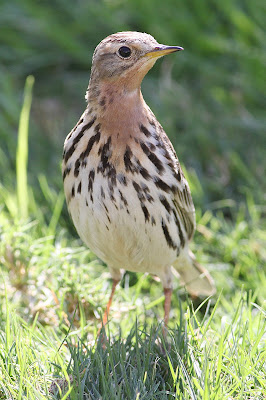Today was rather quiet with little to report from the local patch except for an unlikely twosome - a retreating-to-the-barn Barn Owl and a fly-over Ring-necked Parakeet at Conder Green. There are still 26 Black-tailed Godwits and the usual wildfowl, waders and brown-jobs singing from the roadside and the hedgerows.
Barn Owl
You can’t win them all, so today I’m posting more pictures from our recent Menorca holiday. "Click the pics" to see Menorca in a colourful slide show.
In addition to birds this post features a number of photos from the historic and picturesque town of Alaior, just a mile or two inland from some of the holiday resorts frequented by large numbers of visitors to Menorca. It is such a pity that towns like Alaior, Es Mercadal, Ferreries and Sant Lluis remain unexplored by many tourists. These charming and lovely municipalities remain true to the unspoilt nature of the island; within their quiet streets there is much to discover and appreciate.
A number of long abandoned salt workings/sea inlets of the northern coast of Menorca hold a good variety of waders in the right seasons. Our wader list from the two sites Ses Salines and Addaia included Black-winged Stilt, Greenshank, Ringed Plover, Little Ringed Plover, Little Stint, Curlew Sandpiper, Dunlin, Ruff, Wood Sandpiper, Common Sandpiper, Avocet and Greater Flamingo. Add in a few specials like Blue-headed Wagtail and Ospreys, plus the everyday Nightingale, Cetti’s Warbler, Tawny Pipit, Sardinian Warbler, Woodchat Shrike and Turtle Dove and there are enough birds to satisfy the most demanding of bird watchers.
Ringed Plover and Little Stint
Little Ringed Plover
Black-winged Stilt
Black-winged Stilt
Addaia
Wood Sandpiper
Unlike most places where the species occurs in Northern Europe, the five pairs of Menorcan Ospreys are residents and do not migrate to and from Africa. At Addaia salt pans we saw two Ospreys hunting close together.
Osprey
The route to and from these localities provides a picturesque and untroubled route on quiet roads, plus a reason to stop for lunch on the way back to our south coast hotel. When necessary we would stop to note roadside shrikes, Turtle Doves and Red Kites.
Woodchat Shrike
Turtle Dove
Alaior, the home of the famous Mahon Cheese, is Menorca’s third largest town after Mahon and Ciutadella. With its narrow streets and white washed houses Alaior is a simply beautiful historic town, founded in 1304 by King Jaume 11 of Mallorca.
Its church Santa Eulàlia was rebuilt in the 17th century and remains a wonderful example of Menorca’s historic past.
Alaior - Menorca
Alaior - Menorca
Alaior - Menorca
Alaior - Menorca
Alaior - Menorca
Potential visitors to the island should note that the need for siesta is respected in all of the inland towns and the two major cities, Mahon and Ciutadella. The sacrosanct hours are usually between approximately 1330 and 1730 hours. There’s much to be said for taking an early afternoon nap in the heat of the day and then enjoying the warmth of a Menorcan late afternoon and evening with a glass of Cava to hand.
Alaior - Menorca
Alaior - Menorca
We're on our way south through the island now where Egyptian Vultures cruise overhead all day long and can be seen almost anywhere, often at a good height, occasionally dropping into the fields to search for food on foot. In most cases the cream and black adults seem to be in the majority with just occasional sightings of younger birds like the one below.
Egyptian Vulture
A whistle stop less than a mile from the main road north to south and it’s those Bee-eaters again, this time with a Menorcan snail thrown in.
Be sure to log in soon anyway as there will always be new birds to see on Another Bird Blog. In the meantime you can see more blue skys at Sky Watch Friday or birds on fences at Theresa's Run A Round Ranch.































































































